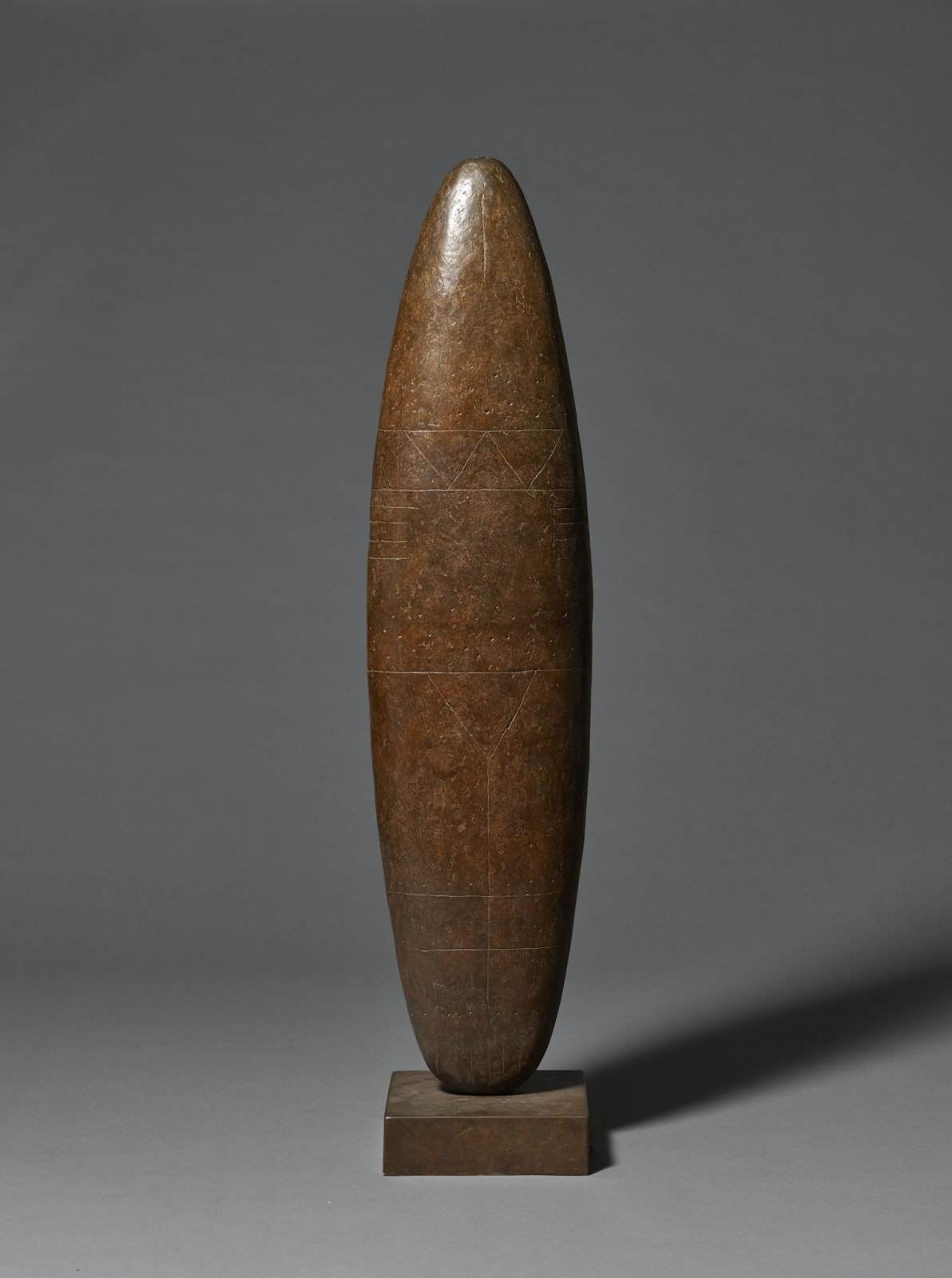William Turnbull 1922-2012
Venus, 1984
bronze
50 x 17 1/4 x 14 inches
127 x 43.8 x 35.6 cm
127 x 43.8 x 35.6 cm
edition number 6/6
In the late 1970s, after several years of experimentation with minimalism, William Turnbull returned to the figurative, organic forms which he had developed earlier in his career. He began by...
In the late 1970s, after several years of experimentation with minimalism, William Turnbull returned to the figurative, organic forms which he had developed earlier in his career. He began by making numerous small works, modelled in clay, and these developed into a series of larger, human-scale idols, cast in bronze.
Turnbull's later series of totemic figures were clearly influenced by both his minimalist columns and abstract paintings. His new sculptures had smoother surfaces than before and were inscribed with fine marks. He also began experimenting more widely with colour, using patinas in warm browns, greens and blue-greys. The forms are simpler than in earlier sculptures and often they are flatter, presenting a front and back, where earlier works were conceived in the round. The power of these forms lies in their simplicity, which focusses attention on the archetypal as well as symbolic nature of their shapes.
Venus, 1984, Queen 1, 1987 (Tate Gallery Collection), Queen 2, 1988, all share the same basic form, and are decorated with rudimentary marks indicating that they are female figures. Roger Bevan likens these simple, flat forms to those of a churinga, an Aboriginal totem, and they are also comparable with both Egyptian schists and various forms found in Cycladic art. David Sylvester however, has noted a more personal resonance in this new form, suggesting that they unconsciously recall the aircraft wings which Turnbull encountered during his four years as a wartime pilot in the RAF. 1
The overall form of Venus was modelled in plaster. As a result, the surface is not completely smooth and, once cast in bronze, has the appearance of weathered stone. The fine lines and indentations Turnbull has inscribed over this base texture suggest anatomical details such as breasts, pudenda, ribs and nose. He has compared these markings to tattoos commenting, 'from the very beginning of time, people have decorated their bodies. They tattoo themselves, they paint their eyes and lips' 2. He has also noted their formal function as, 'a symbolic way of taking your eyes around the sculpture' 3. Finally, each version of Venus has a unique patination - here it is an earthy orange-brown.
1 Amanda Davidson, The Sculpture of William Turnbull, Henry Moore Foundation/Lund Humphries, Aldershot, 2005, p62
2 Ibid, p68
3 Ibid
Turnbull's later series of totemic figures were clearly influenced by both his minimalist columns and abstract paintings. His new sculptures had smoother surfaces than before and were inscribed with fine marks. He also began experimenting more widely with colour, using patinas in warm browns, greens and blue-greys. The forms are simpler than in earlier sculptures and often they are flatter, presenting a front and back, where earlier works were conceived in the round. The power of these forms lies in their simplicity, which focusses attention on the archetypal as well as symbolic nature of their shapes.
Venus, 1984, Queen 1, 1987 (Tate Gallery Collection), Queen 2, 1988, all share the same basic form, and are decorated with rudimentary marks indicating that they are female figures. Roger Bevan likens these simple, flat forms to those of a churinga, an Aboriginal totem, and they are also comparable with both Egyptian schists and various forms found in Cycladic art. David Sylvester however, has noted a more personal resonance in this new form, suggesting that they unconsciously recall the aircraft wings which Turnbull encountered during his four years as a wartime pilot in the RAF. 1
The overall form of Venus was modelled in plaster. As a result, the surface is not completely smooth and, once cast in bronze, has the appearance of weathered stone. The fine lines and indentations Turnbull has inscribed over this base texture suggest anatomical details such as breasts, pudenda, ribs and nose. He has compared these markings to tattoos commenting, 'from the very beginning of time, people have decorated their bodies. They tattoo themselves, they paint their eyes and lips' 2. He has also noted their formal function as, 'a symbolic way of taking your eyes around the sculpture' 3. Finally, each version of Venus has a unique patination - here it is an earthy orange-brown.
1 Amanda Davidson, The Sculpture of William Turnbull, Henry Moore Foundation/Lund Humphries, Aldershot, 2005, p62
2 Ibid, p68
3 Ibid
Provenance
The Artist
Waddington Galleries
Private Collection, UK
Literature
Amanda A. Davidson, The Sculpture of William Turnbull, The Henry Moore Foundation and Lund Humphries, 2005, cat no.226, illus b/w
